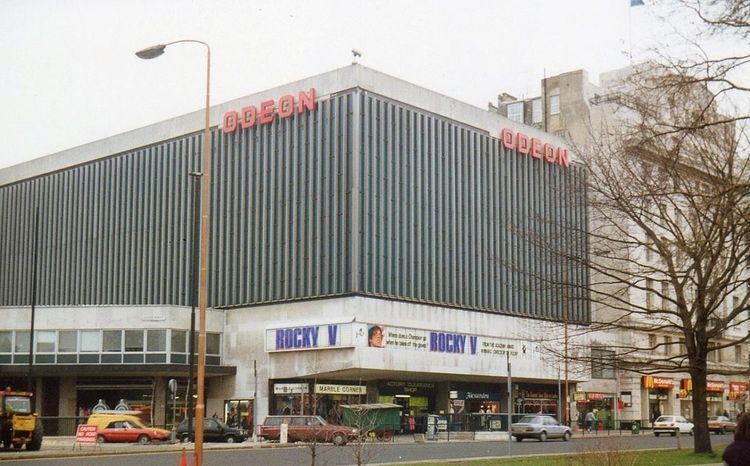 | ||
The Odeon Marble Arch (known as the Regal 1928-1945) was a cinema located opposite Marble Arch monument at the top of Park Lane, with its main entrance on Edgware Road, London. It operated in various forms from 1928 to 2016, and is most famous for once housing a vast screen capable of screening films in 70mm.
Contents
Regal/Odeon Marble Arch (1928-1964)
The cinema was first known as the Regal, opening on 29 November 1928 with Al Jolson in The Singing Fool. A 100-foot (30 m) high facade was constructed in Portland stone. The auditorium was a riot of romanesque motifs and faux-decor, owing much to the atmospheric style of the USA. Structured in traditional circle and stalls, the cinema was a notable addition to the West End. It was also fitted with a Christie organ - the largest theatre organ ever built outside the United States fitted with 2,514 pipes, a 32-note carillon (the only real organ-operated carillon in the United Kingdom) and a wide variety of special sound effects to accompany the films.
Within six months of opening, the cinema was taken over by ABC Cinemas, who operated it until early January 1945. It was then taken over by Odeon Cinemas. It was refurbished by the new owners, but shortly before re-opening it was damaged by one of the last V-1 flying bombs to hit London. So it remained closed until September 1945, when it was re-opened as the Odeon Marble Arch and continued as a first-run house.
However, by the early 1960s its interior was decidedly faded and neglected. Film-runs had by this point declined to minor circuit pictures or even dubbed foreign films: insufficient to fill its large house. So, on 22 March 1964 it closed with The Long Ships, was demolished and replaced by an office block and a new modern cinema, designed by the architectural firm of T.P.Bennett and Son, capable of playing the new widescreen formats. The new cinema, built above the Marble Arch tube station, required elaborate structural shock absorbers to prevent vibrations from the passing trains from disturbing the film projection.
Odeon Marble Arch (1967-1996)
Opening in 1967, the Odeon was the largest cinema constructed in the post-war years. The screen, measuring 75 feet (23 m) by 30 feet (9.1 m), with a depth of curvature of 17 feet (5.2 m), was the largest in the country. Projection was level, beaming from the rear of the stalls, allowing for an even image.
The cinema was constructed to showcase films in the various 70mm processes, as well as conventional 35mm films, allowing for considerable spectacle. Presentations included: Far from the Madding Crowd, A Bridge Too Far, Aliens, Die Hard, Return of the Jedi, Lawrence of Arabia.
Seating was 1360 in total, split between a spaciously raked circle (front and rear) and stalls (stepped towards the rear). Sight-lines were excellent throughout.
The auditorium was a cavernous space, with textured panelling on both side walls, partially concealing curtained backing. Variable lighting was installed in the outer rim of the ceiling to play different coloured schemes over the walls during intermissions. A single set of tabs (curtains) revealed the immense screen. Foyer areas were reached via escalator from a ground floor box office with a fish pond in the upper foyer. A somewhat flatter screen was installed following the revival of Lawrence of Arabia to allow for a less distorted view of the desert skylines. Digital sound was installed in the 1990s, including ceiling speakers.
A special screening in September 1996 of Richard Attenborough's Gandhi in 70mm and six-track magnetic sound marked the end of the Odeon as a single-screen cinema.
Conversion (1997-2016)
In January 1997, the cinema reopened as a 5 screen multiplex, converted within the existing space. The circle was split into two inter-locked screens; rear stalls similarly, with the front stalls utilising the original screen, albeit somewhat reduced in size to allow for the adjusted sightlines from a much smaller auditorium. The projection team at the closing as a single screen, and the opening as a 5 screen were John Paish (Senior Technician), Warren Dargavel (Head Painter and Executive in charge of lamps and multimeter probes), Steffan Laugharne (Chief Teabag Engineer), the late John Peck (Handyman).
The closure and conversion had been mooted for several years, and public outcry at losing such a spectacular venue - most notably in the pages of the London weekly listings magazine Time Out, in which Hellboy screenwriter Peter Briggs played a vocal role - delayed the process on at least one occasion.
In March 2011 Odeon Marble Arch had its 35mm projectors and CP65 sound processors removed and went fully digital in all five screens using NEC digital projectors with Doremi servers, Only screen one retained its Victoria 8 35mm projector and Cinemecanica non rewind system alongside the Digital system for the occasional 35mm shows. The digital network within the cinema was overseen by Unique Digital using its Rosetta Bridge Theatre Management System and any problems could be dealt with remotely from their network operations centre in Norway.
On May 8th 2016, Odeon Marble Arch closed its doors for the final time, and was demolished later that year.
